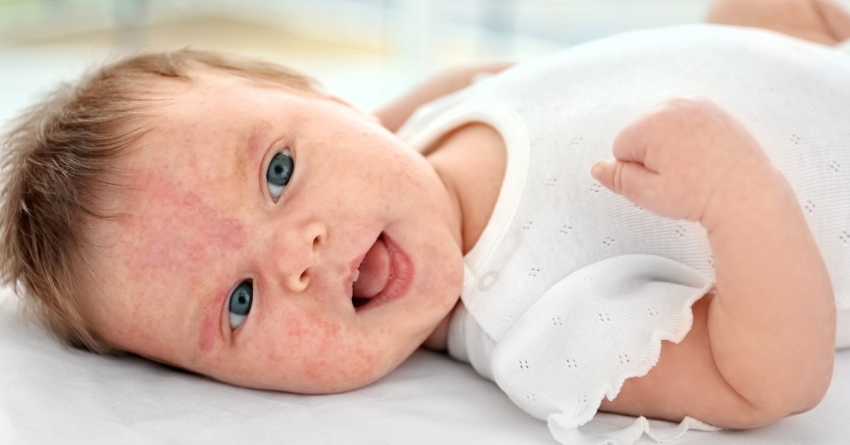Most babies are born with soft, smooth skin, but it does not always remain that way. If the skin becomes rough or dry, parents may try a variety of skin care products to restore that softness. When this dryness progresses to redness, irritation, or discomfort, it is a sign that additional treatment may be necessary. After consultation with a pediatrician or dermatologist, parents may unexpectedly learn that their baby or child has eczema.
But what is eczema? Why does my child have it, and what can be done about it?
What Is Eczema?
Eczema, or atopic dermatitis, is a chronic and recurrent skin condition associated with dryness, irritation, and itching. 15 to 20 percent of infants and children develop it, and 60 percent experience their first symptoms between ages three to six months.
The most bothersome symptom, however, is the itching which compels the child to scratch. This worsens the rash by causing further irritation.
What Are the Signs and Symptoms of Eczema?
 Eczema is characterized by itchy, dry skin that fails to improve despite routine skin care. The skin develops an overall rough, sandpaper-like texture. There are areas of redness or discoloration, skin thickening, and irritation.
Eczema is characterized by itchy, dry skin that fails to improve despite routine skin care. The skin develops an overall rough, sandpaper-like texture. There are areas of redness or discoloration, skin thickening, and irritation.
In addition, the itching can be intense. The infant or child repeatedly scratches the skin, sometimes to the point of bleeding. This cycle of itching, scratching, and worsening irritation is what makes eczema one of the most frustrating skin conditions, both for children and their parents.
Although eczema may appear anywhere on the body, there are locations where it is more common based on age. In infants, eczema typically appears on the face, trunk, and exposed surfaces of the arms and legs. However, it rarely develops in the diaper area. The skin on creases of the arms, behind the knees, or around the eyes is affected in toddlers and older children.
Depending on the eczema severity and efficacy of treatments, these symptoms can wax and wane. Some infants “outgrow” their eczema by age two, while others experience flares until adolescence. 80 percent of cases, however, resolve before adulthood.
What Factors Contribute to Eczema?
Doctors don’t know exactly what causes ezcema, but these are contributing risk factors:
Genetics
Hereditary predisposition plays a role. Research shows that identical twins are more likely to have eczema. Infants and children with eczema usually have a parent or grandparent who has it as well.
Food Allergies
Eczema can coexist with food allergies. Symptoms may develop due to skin contact or regularly eating the offending food. This type of food reaction differs from anaphylaxis; there are no hives, facial swelling, difficulty breathing, or life-threatening symptoms.
In these cases, eczema symptoms may be the only indication of a food allergy. For example, a health breastfed infant begins eating oat cereal as a first food. Within a few weeks, the baby’s skin becomes dry and irritated. He or she attempts to soothe the itching by rubbing against the surface of a crib or changing table, or by directly scratching easy to access skin areas. Food allergy-related eczema improves once the problematic food is identified, and removed from the diet.
In cases of cow’s milk protein allergy, eczema symptoms may develop during the first few weeks of breast or formula feedings. Along with incessant crying, difficulty feeding, and blood in stools, the baby’s skin develops the characteristic dryness and irritation. Most infants outgrow this sensitivity by their first birthday. If not, milk tolerance usually develops by age five. Eczema occurs in 71 percent of children who have a cow’s milk protein allergy.
The “Atopic March”
This describes the association of eczema with allergies and asthma. Essentially, one of these conditions develops during infancy, then progresses to another during the childhood years. In one scenario, the “march” begins with infant eczema, then asthma and allergy symptoms develop during the toddler or childhood years. Food or seasonal allergies are both possible. In other cases, the food allergy symptoms appear during infancy, but eczema and/or asthma develop months to years later.
Here is a clinical example:
A four month old with eczema experiences an allergic reaction to eggs after they are introduced at nine months. Two years later, he or she begins to have sneezing and watery eyes in the spring, along with episodes of wheezing. Although the exact cause of the “atopic march” is unknown, some studies suggest that early inadvertent skin exposure to allergens may increase sensitivity, and trigger the initial symptoms.
What Causes Eczema?
Impaired Skin Barrier Function
The primary reason eczema occurs is because of a problem with the skin’s barrier mechanism. The skin has three layers. The innermost layer consists of subcutaneous fat, and the middle layer, called the dermis, contains nerves, blood vessels, and the oil and sweat glands. The epidermis is the outermost skin layer.
A healthy epidermis acts a waterproof barrier to retain moisture, deflect the sun’s rays, and block entry of anything on the skin surface. It has pigment, infection-fighting cells, and keratin, the primary support structure.
A protein called filaggrin is an important component of keratin that gives strength and integrity to the epidermis. If there is a mutation in the gene responsible for making filaggrin, a weaker version of keratin is produced. This results in skin that easily loses moisture, and that is prone to irritation.
10 percent of individuals of northern European descent and up to six percent of Asians have this mutation. A different mutation has been noted among African Americans, but the overall prevalence is unknown. The resulting defective epidermis creates eczema-prone skin.
Altered Skin Microbiome
Although not visible with the naked eye, the skin is protected by “healthy” bacteria and fungi. This is known as the skin microbiome, and is similar to that of the digestive tract. Its components differ between each person and by age group. The first exposure occurs at birth, either via vaginal delivery or from skin contact during a cesarian section. The skin microbiome undergoes a variety of changes until age three, and then again during puberty.
This important layer of protection helps to maintain the barrier function of skin. If it becomes unbalanced, skin irritation is more likely to occur.
One theory on why the composition of the skin microbiome may change is the “hygiene hypothesis.” It is thought that highly sanitized environments reduce the amount of normal flora. As a result, cases of eczema are more common in such communities. A change in the microbiome also increases the risk harmful bacteria penetrating the epidermis. This can cause eczema infections. Staphylococcal aureus is the most common bacterial infection seen in infants and children with eczema.
Weather
Parents may notice more eczema symptoms in certain weather conditions. During cold weather months, dry cold air and indoor heat can exacerbate symptoms. It can be difficult to keep the skin adequately moisturized.
A smaller percentage of infants and children experience eczema during warm weather months. In these cases, abnormalities of sweat production appear to increase skin inflammation. Sweating also may increase the sensation of itching which can result in more scratching and irritation. Airborne pollens are also more prevalent in warm weather.
In children who are sensitive, skin contact with tree pollen, grasses, or ragweed can trigger eczema flares.
How Does Eczema Affect Quality Of Life?
The itching associated with eczema can be particularly bothersome. It is thought to be caused by abnormally long sensory nerves within the skin. This itching may be more noticeable at bedtime, making it difficult to fall asleep. This may cause frequent waking to scratch affected skin areas, or sudden movements while asleep.
Infants may cry throughout the night, and need more daytime naps. Toddlers and older children may seem irritable, hyperactive, or have tantrums during the day.
Recent research indicates that eczema can also be painful. The lack of sleep and inability to relieve their child’s discomfort can be frustrating for parents.
Eczema can also have psychological effects. Depending on its severity and body location, the skin’s irritated appearance can be upsetting for both parents and children. Some kids may attempt to hide their skin with clothing, or avoid situations where their skin is exposed. Parents are often concerned about skin pigmentary changes.
Trying multiple remedies and treatments with limited success can also be stressful.
Ways to Minimize Eczema Flares and Severity
It is important for anyone with eczema to have a diligent skin care regimen.
Creams, emollients, and ointments applied to the skin on a daily basis can prevent eczema flares, and reduce skin moisture losses. Applying them several times a day may be necessary. Many options are available, but parents may need to try several to find the best product. What may be an effective moisturizer for some children may be ineffective for others.
Wet wraps applied to the irritated skin at bedtime can facilitate healing in stubborn areas.
A cool mist humidifier in the child’s room can reduce the dryness of indoor heat during the winter.
Bathing is important for keeping the skin clean, and to reduce infections. However, if done too frequently or for too long, it may worsen eczema symptoms. Infants and younger children usually do well with a bath every two to three days. Care should be taken to avoid very hot water which can irritate dry skin.
Fragrance-free, dye-free soaps and body washes are gentler on eczema-prone skin. “Sensitive skin” detergents should also be used for laundering clothing, towels, and bedding.
Treatment Options
Topical Medications
Topical steroid creams have been the mainstay of eczema treatment for years. When used appropriately, they provide significant relief of itching, and reduce skin irritation and inflammation. In addition to a good skin care routine, they are the first line of treatment recommended by doctors.
Some parents, however, express concerns about their safety. For this reason, low potency versions are prescribed for a limited number of weeks to reduce the likelihood of side effects. These include skin thinning or stretch marks.
Stronger topical steroids are reserved for severe cases, and are used for shorter durations because of absorption through the skin. Steroid creams are not recommended for use around the eyes or on genital areas.
There are two steroid-free medications that work differently to reduce eczema symptoms. Crisaborole is approved for use as young as age three months, and tacrolimus and pimecrolimus are appropriate for children over the age of two. These products can be used on areas of the body where steroid creams should not be applied, and may be used daily.
Dietary Changes
When a child has food allergies, removing these foods from the diet reduces eczema flares.
For infants with a cow’s milk protein allergy, this includes breastmilk and formula sources. Because this protein can be transmitted to infants via breastmilk, their mothers should avoid cow’s milk, yogurt, cheese and other such foods from their diets. Formula fed infants should be given a hypoallergenic infant formula in which the cow’s milk protein is broken down into a form that does not cause allergic reactions.
Itch Control
At times, despite the best skin care regimen, itching significantly affects the quality of life. In such cases, oral antihistamines can be effective, especially when given at bedtime. They not only reduce the itching, but their sedative effects may improve sleep quality. These options should always be discussed with a doctor before administering them.
Colloidal oatmeal baths and skin treatments can be helpful for calming the itch, and healing the skin. However, such products should be avoided if a child has an oat allergy.
Biologics
Omalizumab and dupilumab are injectable medications that can improve eczema. They affect specific components of the immune system that cause allergy, asthma, and eczema symptoms.
These are considered “last resort” treatments, used only when conventional measures have failed. Currently, they are only approved for ages six and up.
Frequently Asked Questions About Ezcema
Should certain foods be avoided in toddlers with eczema?
There is no specific food known to cause eczema. However, if a toddler has been diagnosed with a food allergy, this food should be avoided. Doing so reduces the likelihood of eczema or other allergic symptoms.
Although extended relatives may encourage it, continuing to allow the child to eat the allergenic foods does not reduce sensitivity to them. On the contrary, these exposures worsen eczema and other allergy symptoms.
What foods can help cure eczema? What is the best infant formula for eczema?
There are no known food cures for eczema. Unless a baby has a cow’s milk protein allergy, the standard infant formulas available on the market are safe to give.
Can gluten cause eczema in toddlers?
Gluten is a wheat protein that can cause two types of adverse reactions. Celiac disease is an inflammation of the intestines that develops when gluten-containing foods are eaten. Children with celiac disease experience frequent stomach pain, bloody diarrhea, and poor weight gain or growth. This condition is not associated with eczema or any other type of rash. Celiac disease tends to be hereditary.
In children who have a wheat allergy, gluten causes immediate allergic symptoms such as hives, facial swelling, breathing difficulty, and vomiting or diarrhea. Milder cases, may be associated with a runny nose and eczema, but continuing to eat such foods increases the risk of a more severe reaction.
How does eczema differ from cradle cap? How are they treated?
Infantile seborrhea is also known as “cradle cap.” It is a rash that involves the overproduction of oil from the sebaceous glands. A fungus that is part of the skin microbiome, Malassezia furfur, also contributes to its development.
Although “cradle cap” may be present on an infant’s face, it typically begins on the scalp, producing flakes that resemble dandruff. It can spread from head to toe, and involve the diaper area. Seborrhea may come and go throughout the first year of life. It is typically managed by loosening the scalp flakes with an emollient, then washing the hair with either a baby shampoo or one recommended by a doctor.
In contrast, eczema can appear anywhere on the body, but typically spares the scalp and diaper area. It feels very dry instead of oily. Although eczema symptoms can wax and wane, a child may or may not outgrow it. Because of skin dryness, first line eczema treatments are creams, emollients, or ointments.
It is possible, however, to have both eczema and seborrhea. The Malassezia fungus may overgrow on areas of eczema on the face and neck. In this case, both a hydrocortisone and an anti-fungal cream may be prescribed.
How does baby acne look compared to eczema?
Normal baby acne develops within the first few weeks of life. The spots appear very much like mild acne seen in adolescents and adults. Red bumps with central “white heads” form on the cheeks, and sometimes spread toward the mouth or temple areas. No treatment is needed, and most cases resolve by four months old.
What home remedies can be helpful in treating eczema?
Before trying any home remedies, parents should first consult a doctor. If a child is not allergic to oats, colloidal oatmeal baths and moisturizers can reduce skin itching and irritation. Some parents find coconut oil to be a very effective moisturizer.
Does a breastmilk bath help eczema?
Most studies on the use of breastmilk to treat eczema have produced inconsistent results. One Iranian study did show skin improvement with breastmilk that was similar to skin treated with a low potency hydrocortisone cream.
When should I worry about my baby’s eczema?
If yellow discharge, pus, or blisters develop, these could be signs of infection and warrant a doctor visit. It is also a good idea to seek help if the eczema is worsening instead of improving.
How does eczema look on different skin types?
On fairer skin, eczema usually appears red and inflamed. Darker skin tones develop the same inflammation, but with increased pigment and less redness.
As the skin responds to treatment, it may appear lighter or darker in previously affected areas. This is called post-inflammatory hypopigmentation or hyperpigmentation. These skin changes are due to the inflammatory aspect of eczema, and not from a hydrocortisone cream or other treatment. After several months without eczema symptoms, the normal skin color returns.
Takeaway
So, to summarize, ezcema in childen is a common, ichy rash that in most cases resolve before adulthood and sometimes early in childhood. It may be related to food allergy, but not always. Possible food allergies should always be investigated and addressed. If a diligent skin care routine does not help enough to manage the ezcema and prevent the iching, it is best to consult a doctor for more effective treatments.
Read Next
- How To Cure Cradle Cap And Eczema In Babies?
- Signs Of Milk Protein Allergy or Lactose Intolerance In Toddlers and Babies
Research References
- Filaggrin plays important role in skin barrier
- Eczema in Babies and Children
- Eczema Prevalence, Quality of Life and Economic Impact (nationaleczema.org)
- Current Understanding in Pathogenesis of Atopic Dermatitis
- Influence of Atopic Dermatitis on Cow’s Milk Allergy in Children
- Childhood atopic dermatitis: current developments, treatment approaches, and future expectations
Does your child have eczema? What do you do to manage it? Share your experiences by leaving a comment!

Paula Dennholt founded Easy Baby Life in 2006 and has been a passionate parenting and pregnancy writer since then. Her parenting approach and writing are based on studies in cognitive-behavioral models and therapy for children and her experience as a mother and stepmother. Life as a parent has convinced her of how crucial it is to put relationships before rules. She strongly believes in positive parenting and a science-based approach.
Paula cooperates with a team of pediatricians who assist in reviewing and writing articles.







